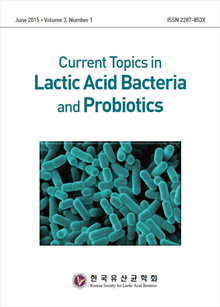간행물
Current Topic in Lactic Acid Bacteria and Probiotics KCI 등재후보 한국유산균·프로바이오틱스학회지

- 발행기관 한국유산균·프로바이오틱스학회
- 자료유형 학술지
- 간기 반년간
- ISSN 2287-853X (Print)
- 수록기간 2013 ~ 2024
- 주제분류 의약학 > 생리학 의약학 분류의 다른 간행물
- 십진분류KDC 573DDC 663
권호리스트/논문검색
Vol. 5. No. 1 (2019년 6월) 5건
Review Article
1.
2019.06
서비스 종료(열람 제한)
Ginseng, the root of the Panax ginseng, has been widely used as a traditional herbal medicine in Korea, China, and Japan for thousands of years. Now ginseng has become popular as functional health food and natural medicine and it is one of the bestselling natural products in the world. Gut microbiota has been found to play an important role in the metabolism and pharmacological action of orally administered ginseng. Recent animal and clinical studies have shown that compound K (20-O -beta-D-glucopyranosyl-20(S)-protopanaxadiol, CK) is the major ginsenoside metabolite deriving from gut microbiota-induced biotransformation and is more efficiently absorbed into the systemic circulation than its parent ginsenosides. Since ginsenoside metabolism varies between individuals depending on the population of gut microbiota, much attention paid to the transformation of major ginsenosides into more pharmacologically active ginsenosides using diverse methods including heating, acid hydrolysis, microbial conversion, and enzymatic treatment. Recently, in food and drug industry and academia, the development of fermented ginseng products using probiotic bacteria is being intensively studied due to the potential health benefits of ginsenoside metabolites and probiotics. This review summarizes recent studies on the metabolism of ginsenoside by gut microbiota and biotransformation of ginsenoside using lactic acid bacteria and their enzymes.
Research Article
2.
2019.06
서비스 종료(열람 제한)
Oligossaccharides have beneficial effects on the immune system, atopy and skin health according to the prebiotic effect on intestinal microflora. Due to the excellent physiological functions of these oligosaccharides, the demand for prebiotics is rapidly increasing in the world. In this review, it has been shown that galactooligosaccharide( GOS) intake improves skin health and atopic eczema and fructooligosaccharide( FOS) prevent atopic dermatitis in human clinical trials. These results indicate that oligosaccharides are sufficiently applicable as a functional food for improving skin health and skin diseases.
3.
2019.06
서비스 종료(열람 제한)
This study evaluated the effects of probiotics on the quality properties of standard pork cutlet (SC) and oven cooking type pork cutlet with probiotics (OCP). Higher (p <0.0001) moisture and protein contents were observed in OCP compared to SC. Fat content of OCP was lower (p<0.0001) than SC. There was no significant difference in CIE color values between SC and OCP. The pH and lipid oxidation values of OCP were lower (p<0.0001 and p<0.01, respectively) than SC counterpart. Based on instrumental texture profile analysis, there was no significant difference in the springiness and cohesiveness between SC and OCP. However, the hardness, gumminess, and chewiness of OCP were higher (p<0.0001) than SC. Crispiness by sensory panel was higher (p<0.0001) in OCP than SC. The results showed that the oven cooking type pork cutlet added probiotics could improve potential of pork cutlet physicochemical properties and give physiological functional ability.
4.
2019.06
서비스 종료(열람 제한)
Nowadays micro-dust is a serious problem in Korea. In particular micro-dust contains heavy metals such as Pb (lead) and Cd (cadmium) which negatively effect on human health. In this study, we intended to isolate lactic acid bacteria which can scavenge the heavy metals. Firstly we isolated two lactic acid bacteria which were resistant to Ag, Cu, and Zn (30-100 mM AgNO3, CuSO4, ZnSO4 in MRS broth). The two lactic acid bacteria CJNU 1877 and JG 15 were identified Lactobacillus paracasei and Enterococcus faecium, respectively. Subsequently the strains were inoculated in MRS broth and agar plate where 100 ppm of Pb(NO3)2 and CdSO4 were added, respectively. They did grow in the conditions and we found aggregations from 24 h cultures, indicating the strains can absorb the heavy metals, which was further proved by scanning electron microscopy (SEM) and Inductively Coupled Plasma-Optical Emission Spectrometer. Therefore the isolated lactic acid bacteria can be used as a probiotics harboring heavy metal scavenging activity.
Note
5.
2019.06
서비스 종료(열람 제한)
Lactobacillus pentosus A67 and L. planarum subsp. plantarum C2 was tested the probiotics characterization such as acid, bile acid and antibiotics resistance. Isolates were isolated from the traditional Korean food, collected from traditional markets and homes in Seoul and Gyeonggi Province, and were selected the isolates A67 and C2, which were the most antibacterial to E. coli. According to the analysis of 16S rRNA base sequences, the results showed that L. pentosus ATCC 8041 (similarity 100%), and L. plantarum subsp. plantarum ATCC 14917 (similarity 100%). L. pentosus A67 showed a survival rate of about 98.35% and the L. plantarum C2 showed a survival rate of about 95.62% at pH 2.5, respectively. L. pentosus A67 showed a survival rate of about 94.56% and the L. plantarum C2 showed a survival rate of about 88.81% on the 0.3% bile salt, respectively. L. pentosus A67 and L. plantarum C2 were survived by antibiotics such as the quinolone, aminoglycoside, macrolide, glycopeptide, tetracycline, cephalosporin and phenicillin families. On basis of these results, L. pentosus A67 and L. plantarum C2 are the candidates for useful probiotics.

